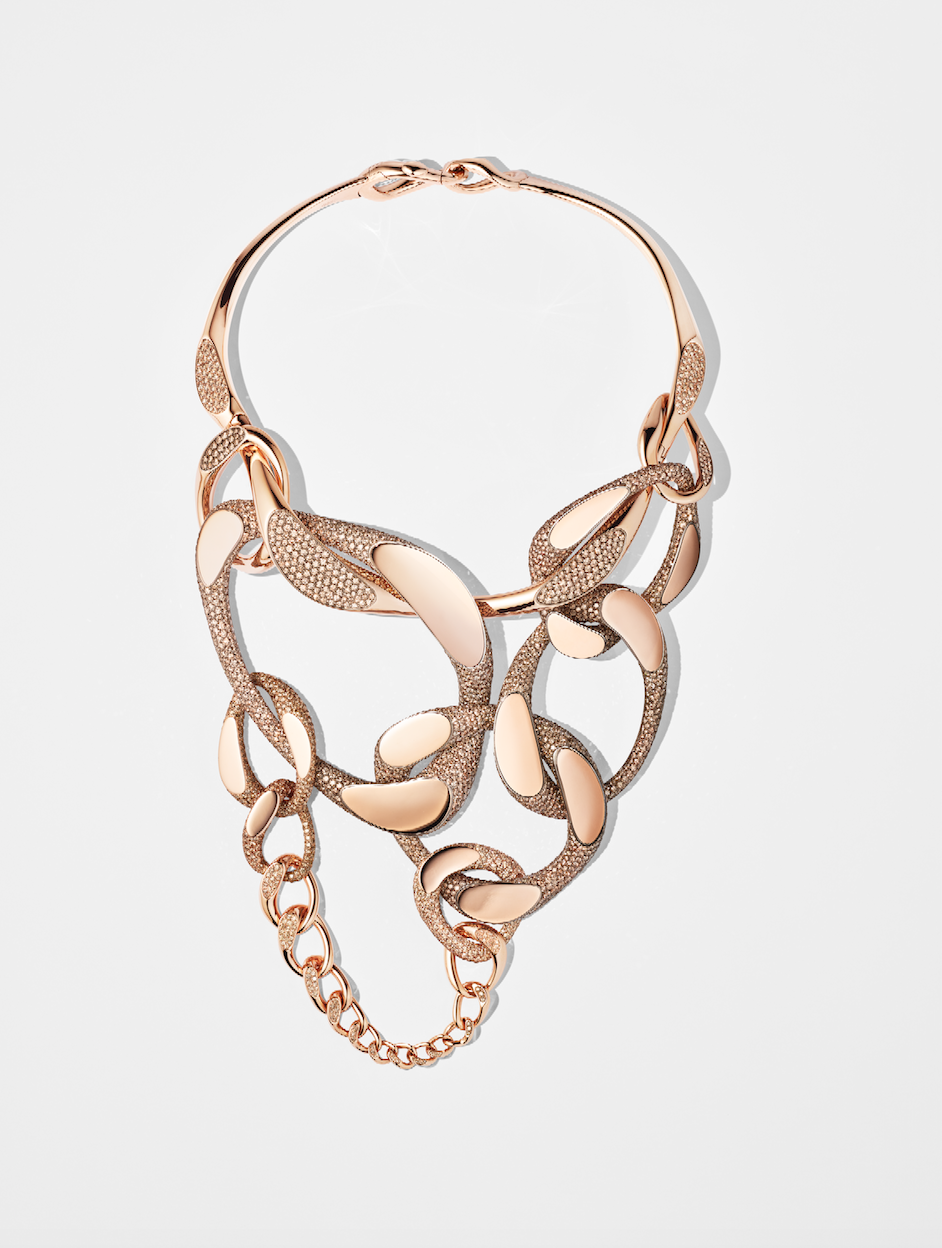
Earlier this month, Hermès celebrated the American debut of its latest high jewelry collection, Enchaînements Libres, with a dazzling spectacle in New York City. The new line—comprised of statement necklaces, earrings, bracelets, and a ring—was presented alongside a modern dance performance choreographed by Christian Rizzo, who meditated on how movement articulates these wearable works of art.
A pair of interlocking dancers commanded Lincoln Center’s Appel Room stage before a procession of black-clad, dramatically-accessorized models circulated the space. The moody showcase marked the third collaboration between Hermès and Rizzo, the esteemed director of the International Choreographic Institute who melds dance, fashion, and visual art with mastery.
A dancer wears a piece from the Enchaînements Libres collection. Photo courtesy Sandra Nanez of BFA and Hermès.
Rizzo first partnered with the luxury label in 2004 when he designed a backdrop for Le Cas du Sac, a scarf-patterned bag that Hermès produced for an exhibition at the Musée de la mode et du Textile in Paris. Over a decade later, in 2016, Hermès commissioned Rizzo’s multi-media installation, entitled Avant la nuit dernière, at the annual Parisian art festival, La Nuit Blanche.
“All of the pieces in this jewelry collection have chains and links in common,” Rizzo said. “For me, they evoke all types of collisions and embraces, like pivots between two bodies, and all the possibilities of movement.”
The Hermès Grand Jeté necklace. Photo by Remy Lonvis and Hermès.
Enchaînements Libres, or “Freedom in chains,” references the physical and figurative significance of the link: the building block of metal jewelry, as well as a symbol of strength and attachment, be it connectivity or bondage. Hardy endeavored to defy the chain’s connotations of restraint and visual homogeneity through bold pieces characterized by asymmetry, spontaneity, and the refined assemblage of colors and materials.
Hermès’ collection is subsequently made up of six thematic variations on the chain, including Adage Hermès, an oversized necklace of linked ellipses encrusted with over 110 carats of diamonds; Hermès Voltige, an exquisite yellow gold and diamond necklace, bracelet, and earring trio akin to medieval chainmail; and Hermès Grand Jeté, a chunky composite necklace featuring unusual stones such as pink opals, black jade, and orange sapphires.
The Hermès Adage necklace. Photo by Maud Remy Lonvis and Hermès.
“At Hermès, the chain is a fundamental motif that draws on its origins as a harness-maker and saddler, and on a long tradition of chain-making know-how,” says Hermès’ creative director of jewelry, Pierre Hardy. “Taking the chain as a theme is choosing to pay tribute to this unique métier while exploring a shape, a form of great symbolic richness. To build the collection, I started by reflecting on links, their sequence, what connects micro to mega, the very human to the very abstract.”
The concept for Enchaînements Libres was likewise guided by joaillerie de la forme (French for “jewelry of shape”), an ethos which Hardy considers to be a mark of virtuosity for the high jeweler. As a sculptor or a dancer accentuates gesticulation, Hardy considered how the human figure can activate the radiance of a diamond or the mobility of a chain. Because unlike couture, which encases the body, jewelry should allow for unfettered motion.
The Hermès Voltige necklace. Photo by Remy Lonvis and Hermès.
“The whole collection is designed around the body,” Hardy says. “Far from the jewellery of former times, which obstructed movement, these pieces are designed for modern lifestyles. They dance in unison with the bodies that wear them.”